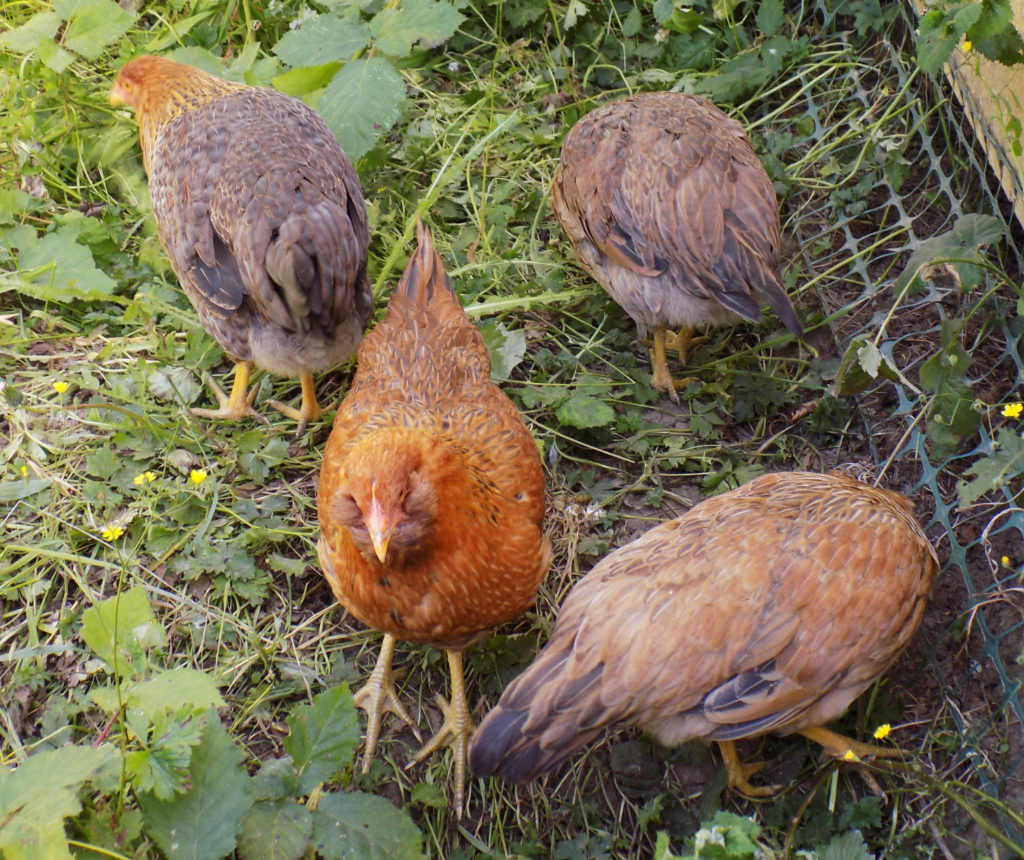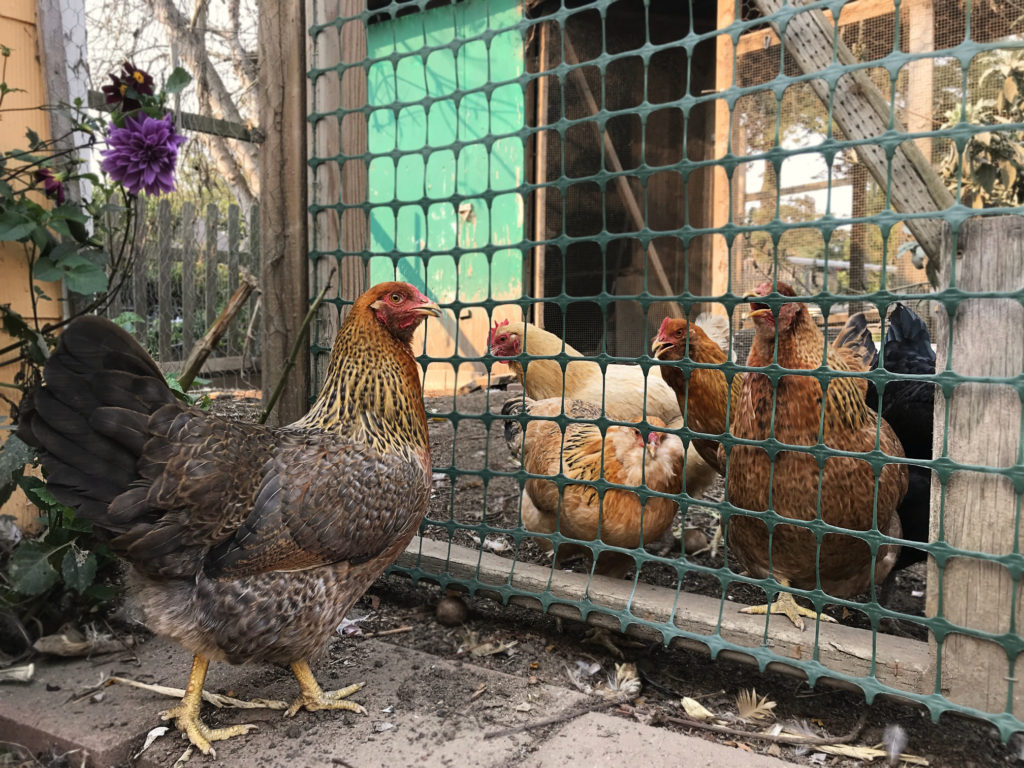At the beginning of the summer, Suzanne had a dozen chickens in a coop next to the tiny house, with a second, smaller coop near the shed at the far end of the yard. The ground of the enclosures around the big coop was bare dirt, all traces of plant life gobbled down by the birds inside, but the area by the back coop was surrounded by brush and weeds with plenty of opportunities for thriving communities of bugs and spiders. You’d think this would be a no-brainer for the chickens, right? Smaller coop with prolific food and snack sources should always win out over bigger barren coop, right?
Not so much. Chickens do not like to be separated from the flock. The small coop — overflowing with snacks! — was the punishment zone, and the chickens hated being relegated to it. Suzanne, however, wanted them to clear out the weeds for her. Her solution was to add a few more chickens to the flock: young ones, who would start out in the small coop and stay there.
She bought four… teenage chickens. I’m sure there’s a name for that in the chicken world, but I’m equally sure that I’m not in the mood to start browsing the internet looking for it. Well, it’s not that I’m not in the mood, but if I fall into an internet rabbit hole today, I will probably not manage to pull myself out anytime soon. So whatever, four teenage chickens, mixed breeds of ameraucana and something else that Suzanne can’t remember.

Suzanne, having had many chickens over the years, doesn’t feel the need to name every chicken anymore. She calls the flock of them, “the ladies,” and pretty much leaves it at that, although a few of the older ones do have names. I’m not so nonchalant about cute teenage chickens, though, so within a few days, I’d decided that these birds should be named after the queens of England.
If you look closely at the above picture, you’ll see that the bird who’s looking out at the camera has some dark fluffy feathers around her beak. Another one has white feathers in the same spot. I named the one with white feathers Elizabeth, for her Elizabethan ruff, and the one with the dark feathers Victoria, for her expression of disapproval. The other two, somewhat interchangeable, were Mary and Anne.
Their royal majesties, however, did not grow up to be interchangeable. To begin with, three of the four of them were escape artists. The area around the small coop was enclosed with soft fencing, boards, and buildings (the shed and the coop), but Victoria, Elizabeth, and Mary treated that whole enclosure thing as more of a suggestion than a rule. I’d regularly go out into the garden and discover chickens wandering free. After all, given a choice between gobbling on thick weeds or tender basil plants and strawberries, who would choose the weeds? Anne, apparently, who never seemed to wander with the others.
Because Suzanne wasn’t inclined to let the chickens feast on the plants that she wanted in her garden, she decided their majesties needed to move into the main coop with the rest of the birds. I was worried about them — wouldn’t they get picked on? Were the older chickens going to share their food? I’m not going to say Suzanne laughed at me, but she definitely didn’t share my concern. And rightfully so.
Possibly I shouldn’t have named them after royalty, because the teenage hooligans took over the main coop within a few weeks. They stay up later than the others — everyone else has gone to bed and they’re still roaming, hunting for the last of the daily pellets of food — but despite their late bedtimes, they sleep on the top rung of the roost. They share it with a couple of the others, but all four of them wind up squished in on the highest row, which is the power position for chickens.
And Mary, formerly the Queen of Scots, now known as Mary-Mary-Quite-Contrary, has continued her escape artist proclivities. She’s still light enough to fly to the top of the fence on the big coop, then fly down on the other side and wander around the garden, selecting leaves of basil and flowers to snack on at her leisure.
Initially, getting her back into the coop was a challenge for me. But chickens are not nearly as stupid as I was always told they were. Now when Mary-Mary gets out, I grab a chicken snack — maybe some scraps of vegetables leftover from cooking, or a handful of berries, or maybe a little granola — and head to the door of the coop. Mary-Mary hurries back to get her share of the fresh loot before I can leave her out of it. She would probably say that human beings aren’t as stupid as she always thought they were.

Yesterday I spent $20 at the feed store to buy a big bag of chicken treats. Suzanne laughed and said the chickens would adore me. I, somewhat smugly, said that her chickens already adore me, and she promised that adoration would turn to worship. I am pretty sure that Mary-Mary is not the worshipping type, however. She thinks those treats are nothing more than her due.
I am ridiculously fond of her.
Pullet chickens. Those are the “teenagers”
Thanks for saving me from the google rabbit hole!
Oh, I love it!! LOL such fun. I love chickens–all sizes and breeds. Just love them.
I am surprised by how much I like them. I never really knew any chickens until this year and they’re just such interesting creatures. They have personalities and attitude. And honestly, I love how straightforwardly mean they are. Chicken society does not demand niceness from its members.
LOL too true–they are territorial and can be vicious!
They can be vicious to one another! And five seconds later, they’re over it, and that night, they’ll huddle up on the roost together and make those little contented sounds they make when they’re all pleased with life.